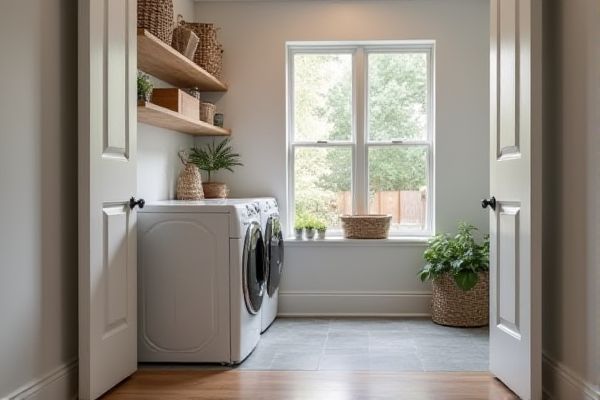
Choosing between interior venting and exterior venting for your dryer impacts energy efficiency and air quality; interior venting recycles warm air but risks moisture buildup, while exterior venting expels humidity and lint outside for safer operation. Discover which venting option best suits your home's needs by reading the full article.
Table of Comparison
| Feature | Interior Venting Dryer | Exterior Venting Dryer |
|---|---|---|
| Venting Location | Exhausts air inside the home | Exhausts air outside the home |
| Installation Complexity | Simple, uses a condensation system | Requires ductwork to the exterior |
| Moisture Control | Condenses moisture internally; needs water drainage | Moisture expelled outside; no internal moisture buildup |
| Energy Efficiency | Generally higher due to heat recycling | Moderate; heat lost through venting |
| Maintenance | Requires regular water reservoir drainage or drainage line | Requires vent duct cleaning to prevent lint buildup |
| Installation Location Flexibility | Can be placed anywhere without exterior wall access | Needs access to an exterior wall or vent outlet |
| Cost | Typically higher initial cost | Generally lower upfront cost |
| Air Quality Impact | No external air expelled; may increase indoor humidity if mismanaged | No impact on indoor air quality |
Introduction to Dryer Venting Options
Interior venting dryers release moist air into the indoor space using a condenser or heat pump system, eliminating the need for external ductwork but requiring proper humidity management. Exterior venting dryers expel hot, damp air through a vent to the outside, effectively reducing indoor moisture and lint buildup but requiring a suitable wall or window opening. Choosing between interior and exterior venting depends on home layout, ventilation feasibility, and moisture control priorities.
What Is Interior Venting?
Interior venting involves directing your dryer's exhaust air into an indoor space rather than outside. This method requires specialized equipment like a condenser or heat pump dryer that recycles moisture and heat, preventing humidity buildup in your home. Choosing interior venting can save you from installing an external duct but demands proper ventilation to avoid mold and air quality issues.
What Is Exterior Venting?
Exterior venting involves directing your dryer's hot, moist air outside through a dedicated vent duct, preventing moisture buildup and improving drying efficiency. This method reduces lint accumulation indoors, enhancing air quality and lowering the risk of mold growth in your laundry area. Your dryer's performance and safety are optimized by ensuring proper installation of an exterior vent system.
Installation Requirements for Each Method
Interior venting dryer installation requires a lint trap or filter system to manage moisture and lint within the home, avoiding the need for ductwork leading outside. Exterior venting dryers necessitate a vent duct that runs from the dryer to an exterior wall or roof, ensuring proper expulsion of hot air and moisture outdoors, which can involve cutting holes and installing vent covers. Proper installation for exterior venting must comply with building codes to prevent issues like backdrafts, moisture intrusion, and lint buildup, while interior venting requires careful maintenance to prevent indoor air quality problems.
Energy Efficiency Comparison
Interior venting dryers recycle hot air within the appliance, reducing energy consumption by minimizing heat loss, whereas exterior venting dryers expel moist air outside, often leading to increased heating costs. Your energy bill may be lower with an interior venting system due to more efficient heat retention and shorter drying cycles. Choosing a dryer with interior venting can enhance overall energy efficiency, particularly in colder climates where venting heat outdoors results in greater energy waste.
Moisture and Air Quality Impacts
Interior venting dryers release moisture and lint directly into your home, increasing indoor humidity levels and potentially causing mold growth and poor air quality. Exterior venting dryers expel hot, moist air outside, reducing indoor moisture buildup and improving overall air circulation. Choosing exterior venting helps maintain healthier air quality by minimizing airborne contaminants and excess humidity inside your living space.
Safety Considerations
Interior venting dryers pose safety risks due to moisture buildup, which can lead to mold growth, increased fire hazards, and poor indoor air quality. Exterior venting dryers effectively expel heat, lint, and moisture outside, significantly reducing the risk of overheating and fire dangers in your home. Choosing exterior venting enhances safety by preventing dangerous lint accumulation and ensuring proper airflow during dryer operation.
Maintenance and Cleaning Needs
Interior venting dryers require frequent cleaning of internal components to prevent lint buildup, which can reduce efficiency and pose fire risks, whereas exterior venting dryers demand regular inspection and cleaning of the external vent to ensure unobstructed airflow and prevent moisture damage. Maintenance for interior venting models centers on sanitizing internal ducts and filters, while exterior venting systems necessitate clearing outdoor vents and checking for blockages from debris or pests. Proper upkeep for both types enhances dryer performance, energy efficiency, and safety by minimizing lint accumulation and ensuring adequate ventilation.
Cost Differences
Interior venting dryers typically cost less initially due to simpler installation and no need for external venting ducts, making them more budget-friendly upfront. Exterior venting dryers may incur higher installation expenses because of the additional venting materials, labor, and potential modifications to your home's exterior. Considering your long-term energy costs and maintenance needs can help you determine which dryer venting option aligns best with your budget and home setup.
Choosing the Right Venting Solution for Your Home
Choosing the right dryer venting solution depends on your home's layout, space availability, and moisture control needs. Exterior venting is the most efficient, expelling hot, moist air outside to prevent mold and maintain indoor air quality, while interior venting systems often require special filters and regular maintenance to manage lint and humidity safely. Evaluating duct length, local building codes, and energy efficiency will help determine whether an interior or exterior vent best supports your laundry area's performance and safety.
 homyna.com
homyna.com